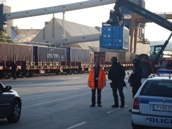Hungarian research reactor fuel returned to Russia
23 October 2008
Some 155 kilograms of high-enriched uranium (HEU) research reactor fuel has been transported from Hungary to a storage facility in Russia by the US National Nuclear Security Administration (NNSA).
 |
| The HEU in Slovenia - from train to ship (Image: NNSA) |
Through NNSA, the USA worked in close cooperation with Hungary, Russia, the International Atomic Energy Agency (IAEA) and the Euratom Supply Agency to return the material in the most complex such shipment completed to date, involving four separate transportation segments.
The used HEU from a research reactor in Budapest was packaged into 13 transportation casks that were loaded into shipping containers and transported under guard by rail to the port of Koper in Slovenia. At Koper, the containers were loaded onto a special cargo vessel and shipped to a secure seaport in Russia, where they were then transported by rail to a secure storage site in Russia. They arrived there this yesterday.
"This shipment of highly enriched uranium from Hungary is the largest shipment of HEU spent fuel under NNSA's Global Threat Reduction Initiative," said NNSA administrator Thomas D'Agostino. "The outstanding cooperation between the United States and Hungary in removing and securing this dangerous nuclear material exemplifies our strong international commitment to global threat reduction and non-proliferation."
The NNSA said that this was the fourth shipment of Russian-origin HEU used fuel to be removed for safe and secure storage over a year-long period following shipments from the Czech Republic (80 kg), Latvia (14.4 kg) and Bulgaria (6.3 kg). It noted, "With the successful completion of this shipment, a total of approximately 1685 pounds (765 kg) of Russian-origin HEU fuel (used and fresh) have been returned from Serbia, Romania, Bulgaria, Libya, Uzbekistan, Poland, Germany, the Czech Republic, Latvia, Vietnam and Hungary."
The project was carried out under the 2004 Russian-US government agreement on cooperation in removing Russian-made nuclear fuel from research reactors to Russia. The primary goal of the Russian Research Reactor Fuel Return (RRRFR) program is to eliminate HEU stockpiles and persuade eligible countries to convert their research reactors from HEU to low-enriched uranium (LEU) fuel upon availability, qualification, and licensing of suitable LEU fuel. Under the RRRFR program, Russia has agreed to take back used and fresh nuclear fuel from research reactors so long as the reactor operators agree to convert the reactors to operate on LEU or shut down. So far, 32 countries have cooperated in the shutdown of a total of 62 HEU-fuelled research reactors and most recently, reactors in Argentine, Ukraine and South Africa have been converted to run on LEU.
The RRRFR program intends to move 2 tonnes of HEU and 2.5 tonnes of LEU used fuel to the Mayak plant over the ten years to 2012. The program envisages 38 shipments (of both fresh and used fuel) from ten countries over 2005-08, then eight or more shipments from six countries to remove all HEU fuel discharged before reactors are converted to LEU or shut down. Seventeen countries have Soviet-supplied research reactors, and there are 25 such reactors outside Russia, 15 of them still operational.